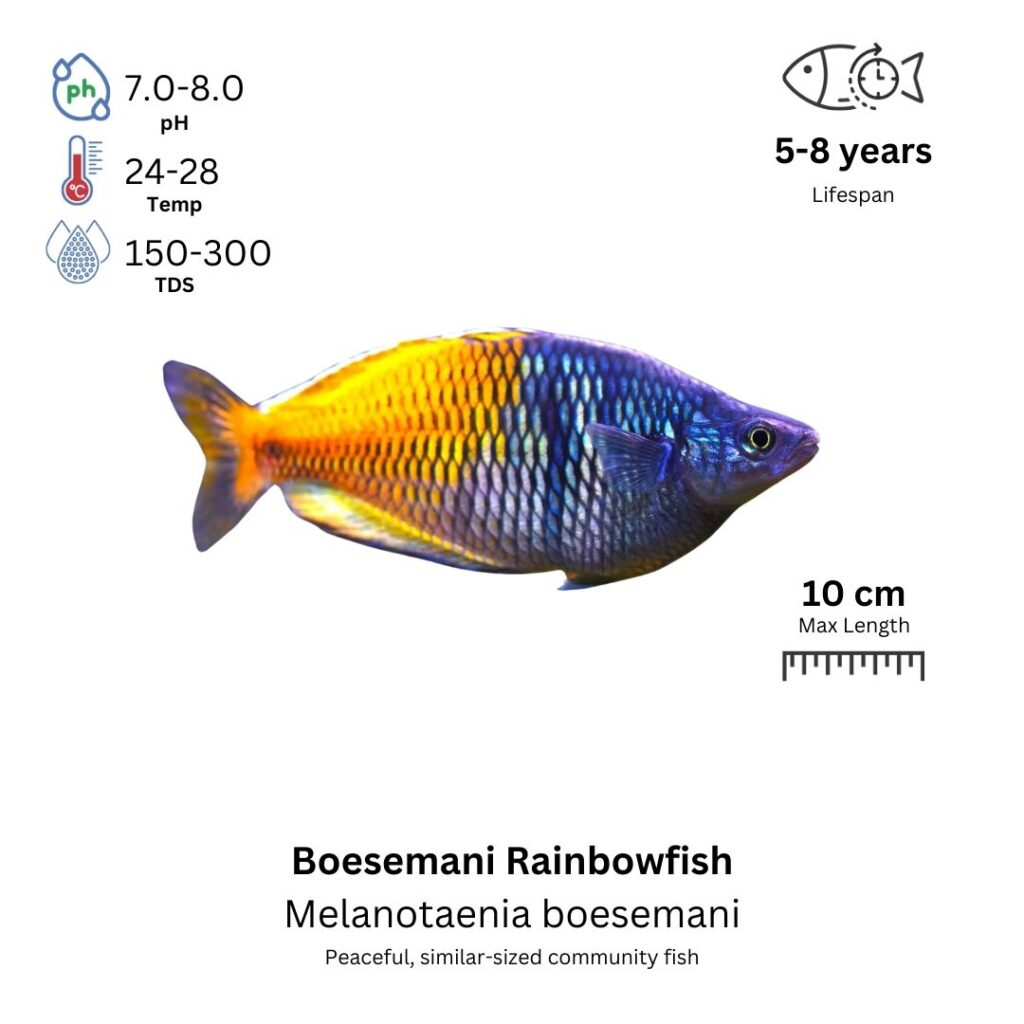Boesemani Rainbowfish
Melanotaenia boesemani

Description
The Boesemani Rainbowfish is a strikingly colorful and peaceful species of rainbowfish, known for its vivid coloration. Adult males are particularly vibrant, with a beautiful gradient of colors that shift from a bright blue on the head to a vibrant orange-red towards the tail. Females, on the other hand, are more subdued in color but still feature the characteristic rainbow hues, though less pronounced. The body is elongated and streamlined, ideal for swimming in schools. These fish are active, peaceful, and social, making them great for community aquariums. They are lively swimmers that are often seen darting around the middle to upper regions of the tank. Their striking colors and schooling behavior make them a popular choice for aquariums focused on peaceful, visually stunning fish.
Habitat Origin
Native to Indonesia, particularly in the rivers and streams of Western Papua New Guinea. They are found in slow-moving or still waters with clear water, abundant vegetation, and moderate water flow. Boesemani Rainbowfish prefer slightly acidic to neutral water conditions and enjoy aquariums that replicate their natural habitats, with plants and plenty of swimming space.
Aquarium
Ideal Number in Aquarium: At least 6 individuals, as they are schooling fish and feel more secure in groups.
Favorite Food

Boesemani Rainbowfish are omnivores and will accept a variety of foods. In captivity, they can be fed high-quality flake food, pellets, live or frozen foods like brine shrimp, daphnia, and bloodworms. They also graze on algae and plant matter, so they benefit from a varied diet that includes both animal-based and plant-based foods. A balanced diet helps maintain their vibrant colors and overall health.
Behavior:
Boesemani Rainbowfish are peaceful, active, and social fish that do best in groups of at least 6 individuals. They enjoy swimming in schools and exhibit synchronized movements, adding dynamism to the tank. These fish are typically found in the middle to upper regions of the aquarium, where they actively swim in open water. They are not aggressive and are ideal for community tanks with other peaceful fish. They can be housed with small tetras, rasboras, and other non-aggressive species. However, care should be taken when choosing tankmates, as large or overly aggressive species may stress them.
Special Care:
Boesemani Rainbowfish are hardy, but they thrive best in stable water conditions. They require regular water changes to maintain high water quality and should be kept in a well-filtered tank. Providing plenty of swimming space and some plants for cover will help keep them happy and reduce stress. They are also sensitive to sudden changes in temperature or water quality, so it’s important to keep their environment consistent.
Compatibility with Other Fish:
Yes, Boesemani Rainbowfish are compatible with many other peaceful species. They can be kept with small tetras, rasboras, catfish, and other rainbowfish. They should be housed with species that are similar in size and temperament, as they can be intimidated by more aggressive or larger fish. As they are schooling fish, they do best when kept in groups, where they feel more secure and exhibit their natural behavior.
Breeding Setup
Setting up a separate breeding tank is highly recommended for Boesemani Rainbowfish to allow better control over water quality and reduce stress or predation. A 100-liter (26-gallon) tank is suitable for a breeding pair, with larger tanks preferred for multiple pairs. Maintain a pH of 6.5–7.5, temperature between 24–28°C, and GH of 5–15 dGH. Use a sponge filter or gentle internal filter to avoid strong currents. Add fine substrate and live plants like Java moss or floating duckweed to provide egg-laying surfaces and shaded areas. Moderate lighting is ideal to replicate natural conditions.
Conditioning for Breeding
To condition Boesemani Rainbowfish for spawning, provide a varied, protein-rich diet including high-quality flakes, live foods (brine shrimp, daphnia, bloodworms), and frozen options like mysis shrimp. A nutrient-rich diet will help both males and females build the energy reserves needed for spawning. Conduct weekly 25% water changes to ensure optimal water quality, which is critical to trigger breeding behavior and maintain the health of the fish.
Spawning Process
Boesemani Rainbowfish are egg-scatterers. The male courts the female by flashing vivid colors and engaging in chasing behavior. The female releases 50 to 200 adhesive eggs, which scatter and stick to plants, decorations, or substrate. Once eggs are laid, it’s important to remove the adult fish to prevent potential egg predation, even though they are not aggressive egg-eaters. Keeping the eggs safe from disturbances improves hatch rates.
Fry Care
Eggs will typically hatch within 24 to 48 hours, depending on temperature. Fry remain near the hatch site absorbing their yolk sacs for a few days. Once they are free-swimming, begin feeding them infusoria, liquid fry food, or microscopic algae. After several days, introduce baby brine shrimp or other fine live foods. Perform daily 10–15% water changes to maintain clean water and keep temperature and parameters stable. Regular monitoring of ammonia and nitrate levels is vital for fry survival and growth.
Important Notes
Boesemani Rainbowfish are ready to breed at 6 to 12 months of age. Males are slimmer and exhibit more vibrant colors, especially during courtship, while females are generally rounder and less colorful. To avoid stress, maintain stable water parameters, minimize sudden environmental changes, and avoid aggressive or boisterous tankmates. A calm and well-maintained environment will greatly enhance the success of the breeding effort.
